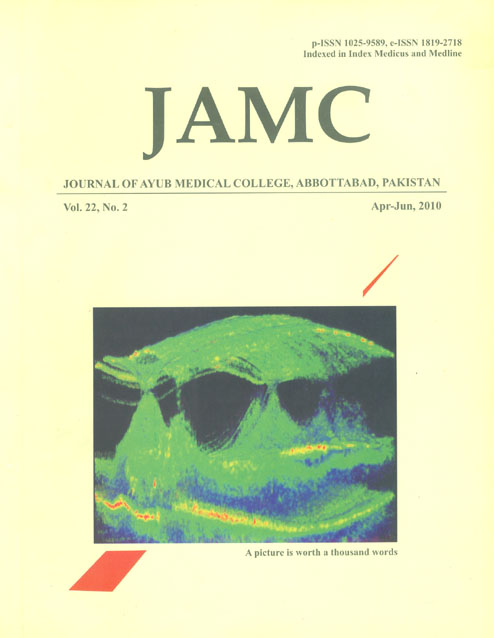ASSESSMENT OF PREGNANCY OUTCOME IN PRIMIGRAVIDA: COMPARISON BETWEEN BOOKED AND UN-BOOKED PATIENTS
Abstract
Background: Primigravida (PG), defined as a woman who conceives for the first time, is in a high-riskgroup. Objective of this study was to evaluate the pregnancy outcome in booked and un-booked
primigravida. Methods: This was a hospital based comparative study conducted in Women and
Children Hospital Abbottabad from May 1998 to November 1999. A total of 322 patients were
included in the study. Inclusion criteria was all primigravida, both booked as well as un-booked
patients. Evaluation was done by taking detailed history, clinical examination and relevant
investigations. Antenatal, intrapartum and postnatal complications were noted in the mothers. Perinatal
morbidity and mortality was assessed in both the groups. Results: Out of 322 cases, 52 patients were
booked and 270 patients were un-booked. Majority of un-booked patients belonged to the rural areas
and were from lower socioeconomic group, between the age group of 15-35 years. The rate of
instrumental deliveries was high (87.5%) in un-booked patients as compared to booked patients
(12.5%). Caesarean section rate in un-booked patients was higher (76.5%) as compared to booked
patients (23.5%). Twenty-three (20%) patients of un-booked group presented in emergency mainly
with obstructed labour. Twenty-two (19.8%) patients had pregnancy induced hypertension, while
foetuses of 48 (43.2%) patients developed foetal distress. Antipartum haemorrhage was present in 12
(10.8%) patients, while prolonged labour with foetal distress was noted in 26 (23.4%) patients in unbooked group. Postpartum haemorrhage and puerperal pyrexia was more common in un-booked
patients (7.7% and 18.6% respectively). Perinatal mortality was high in un-booked patients (19.5%) as
compared to booked patients. Conclusion: Primigravida are high-risk patients. Comprehensive
antenatal care should be provided in this group of patients to have better maternal and foetal outcome.
Keywords: Primigravida, Pregnancy, Outcome, Complications, Women, Antenatal, Maternal, foetal
References
World Health Organization. The prevalence of anaemia in
woman. A tabulation of available information. Geneva:
WHO;1992.
Jackon DJ, Keel EB, Green SDR, Mokil JCK, Elton RA, Cutting
WAM. Severe anemia in pregnancy: A problem of primigravidae
in rural Ziar. Tren R Soc Trop Med Hyg 1991;85:829-32.
Garn SM, Ridella SA, Petzold AS, Falkner F. Maternal
hematologic levels and pregnancy outcomes. Semin Perinatol.
;5(2):155-62.
Allen LH. Iron deficiency. Increases risk of pre-term delivery.
Nutr Rev 1993;512:49-51.
Elia M. Nutrition. In: Kumar, Clark (eds). Clinical Medicine. 6th
ed. London: Saunders; 2005. p. 237-8.
Harrison KA, Ibeziako PA. Maternal anemia and fetal birth
weight. J. Obstet Gynaecol Br. Commonw 1973;80:798-804.
World Health Organization. Maternal Mortality Ratios and
Rates: a tabulation of available information. 3 edition,
WHO/MCH/MSM/91.6, Geneva; 1991.
Starrs A. Preventing the tragedy of maternal deaths. Report
on the international safe motherhood conference; Nairobi,
Kenya; 1987.
Severity of anaemia and operative mortality and morbidity.
Lancet 1988; 1(8599):1392-3.
Abu-Heija A, Ali AM. Is breech presentation in Nulli parous
women at term an absolute indication for caesarean section? Ann
Saudi Med 2001;21(3-4):190-2.
Hameed N, Ali MG. Maternal blood loss by expansion of
uterine incision at caesarean section-a comparison between
sharp and blunt techniques. J Ayub Med Coll Abbottabad
;16 (3) 47-50.
Stålberg K, Bodestedt A, Lyrenås S, Axelsson O. A narrow
pelvic outlet in creases the risk for emergency cesarean section:
Acta Obstet Gynecol Scand 2006: 2006; 85(7):821-4.
Al-Zirqi 1, Vangen S, Forsen Letal: Effect of onset of labor and
mode of delivery on severe post partum haemorrhage. Am J Obst
Gynecal: 2009;201(3):1-9.
Lotez AO. Causes of death an assessment of global pattern of
mortality around 1985. Word Health Stat Quart 1990;43:91-104.
Korejo R, Jafary N. Perinatal mortality in Jinnah
Postgraduate Medical Centre Karachi; J Pak Med Assoc
;41:151-4.
Glanzner CM, Abdullah MI, Russel IT, Templeton AA.
Postnatal care a survey of patients experiences, Br J
Midwifery 1993;1:67-74.
Downloads
Published
How to Cite
Issue
Section
License
Journal of Ayub Medical College, Abbottabad is an OPEN ACCESS JOURNAL which means that all content is FREELY available without charge to all users whether registered with the journal or not. The work published by J Ayub Med Coll Abbottabad is licensed and distributed under the creative commons License CC BY ND Attribution-NoDerivs. Material printed in this journal is OPEN to access, and are FREE for use in academic and research work with proper citation. J Ayub Med Coll Abbottabad accepts only original material for publication with the understanding that except for abstracts, no part of the data has been published or will be submitted for publication elsewhere before appearing in J Ayub Med Coll Abbottabad. The Editorial Board of J Ayub Med Coll Abbottabad makes every effort to ensure the accuracy and authenticity of material printed in J Ayub Med Coll Abbottabad. However, conclusions and statements expressed are views of the authors and do not reflect the opinion/policy of J Ayub Med Coll Abbottabad or the Editorial Board.
USERS are allowed to read, download, copy, distribute, print, search, or link to the full texts of the articles, or use them for any other lawful purpose, without asking prior permission from the publisher or the author. This is in accordance with the BOAI definition of open access.
AUTHORS retain the rights of free downloading/unlimited e-print of full text and sharing/disseminating the article without any restriction, by any means including twitter, scholarly collaboration networks such as ResearchGate, Academia.eu, and social media sites such as Twitter, LinkedIn, Google Scholar and any other professional or academic networking site.










